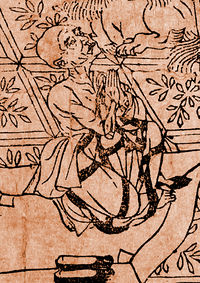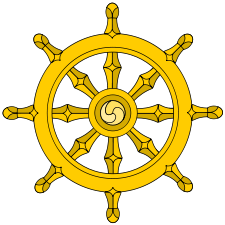Diamond Sutra

The Diamond Sūtra (Sanskrit: Vajracchedikā Prajñāpāramitā Sūtra), is a short and well-known Mahāyāna sūtra from the Perfection of Wisdom (Skt. Prajñāpāramitā) genre, which teaches with an emphasis on the practice of non-abiding.
A copy of the Diamond Sūtra, found among the Dunhuang manuscripts in the early 20th century, is, in the words of the British Library, "the earliest complete survival of a dated printed book."[1]
Contents |
Etymology
The original Sanskrit title of the Diamond Sutra is the Vajracchedikā Prajñāpāramitā Sūtra. A fuller translation of the Sanskrit title would be the Diamond Cutter Perfection of Wisdom Sutra. Some common translations of this title into major Asian languages include:
- Sanskrit: वज्रच्छेदिकाप्रज्ञापारमितासूत्र, Vajracchedikā Prajñāpāramitā Sūtra
- Chinese: 金剛般若波羅蜜多經, shortened to 金剛經, pinyin: jīngāng bōrě bōluómìduō jīng or jīngāng jīng
- Japanese: kongou hannya haramita kyou, shortened to kongou kyou
- Korean: 금강반야바라밀경 (金剛般若波羅蜜經), shortened to 금강경 (金剛經)
- Vietnamese Kim cương bát-nhã-ba-la-mật-đa kinh, shortened to Kim cương kinh
- Tibetan (Wylie): ’phags pa shes rab kyi pha rol tu phyin pa rdo rje gcod pa zhes bya ba theg pa chen po’i mdo
History

The history of the text is not fully known, but Japanese scholars generally consider the Diamond Sūtra to be from a very early date in the development of Prajñāpāramitā literature.[2]
The first translation of the Diamond Sūtra into Chinese is thought to have been made in 401 CE by the venerated and prolific translator Kumārajīva.[3] The Kumārajīva translation has been particularly highly regarded over the centuries, and it is this version that appears on the 868 CE Dunhuang scroll.
Early western scholarship on the Diamond Sūtra is summarized by Müller.[4] Some western scholars also believe that the Aṣṭasāhasrikā Prajñāpāramitā Sūtra was adapted from the earlier Vajracchedikā Prajñāpāramitā Sūtra.[2]
Contents and teachings
The Diamond Sūtra, like many Buddhist sūtras, begins with the famous phrase "Thus have I heard" (Skt. evaṃ mayā śrutam). After Subhuti and the other monks have returned to the monastery to eat the midday meal, having been in the great city of Shravasti begging for their food, Subhuti enters an assembly where the Tathagata is presiding .
In the Zen school
The Diamond Sūtra can be read in approximately fifty-three minutes. It is often memorized and chanted in Buddhist monasteries. This sūtra has retained significant popularity in the Mahāyāna Buddhist tradition for over a millennium.
Dunhuang block print
There is a wood block printed copy in the British Library which, although not the earliest example of block printing, is the earliest example which bears an actual date. The copy is a scroll, about 16 feet long, purchased in 1907 by the archaeologist Sir Marc Aurel Stein in the walled-up Mogao Caves near Dunhuang, in northwest China from a monk who was guarding the caves known as the "Caves of the Thousand Buddhas." The colophon, at the inner end, reads: "Reverently made [caused to be] for universal free distribution by Wang Jie on behalf of his two parents on the 15th of the 4th moon of the 9th year of Xiantong [11 May 868]". This is approximately 587 years before the Gutenberg Bible was first printed.
See also
- Mahāyāna sūtras
- Perfection of Wisdom
- Kumarajiva
- Heart Sutra
References
- ↑ "Sacred Texts: Diamond Sutra". Bl.uk. 2003-11-30. http://www.bl.uk/onlinegallery/sacredtexts/diamondsutra.html. Retrieved 2010-04-01.
- ↑ 2.0 2.1 Williams, Paul. Mahāyāna Buddhism: the Doctrinal Foundations. London, UK: Routledge. ISBN 0-4150-2537-0. p.42
- ↑ The Korean Buddhist Canon: A Descriptive Catalog: K13
- ↑ Müller, Friedrich Max, ed.: The Sacred Books of the East, Volume XLIX: Buddhist Mahāyāna Texts. Oxford: Clarendon Press, 1894, pp. xii-xix
Bibliography
- Thich Nhat Hanh: The Diamond that Cuts Through Illusion: Commentaries on the Prajñaparamita Diamond Sutra. Berkeley: Parallax Press, 1992 ISBN 0-938077-51-1
- Mu Soeng: The Diamond Sutra: Transforming the Way We Perceive the World. Boston: Wisdom Publications, 2000 ISBN 0-86171-160-2
- Friedrich Max Müller, ed.: The Sacred Books of the East, Volume XLIX: Buddhist Mahāyāna Texts. Oxford: Clarendon Press, 1894 ISBN 1-60206-381-8
- Nan Huaijin: Diamond Sutra Explained. Florham Park, NJ: Primordia, 2004 ISBN 0-97165-612-6
- Red Pine: The Diamond Sutra: The Perfection of Wisdom; Text and Commentaries Translated from Sanskrit and Chinese. Berkeley: Counterpoint, 2001 ISBN 1-58243-256-2
External links
- http//www.spiritual-happiness.com/diamondsutra.html
- The Diamond Sutra in romanized Sanskrit and in Sanskrit in Devanagari in the Digital Sanskrit Buddhist Canon.
- Vajracchedikā Prajñāpāramitā Sūtra: English Translation, Lapis Lazuli Texts
- Diamond Sutra: English Translation, by Charles Muller
- Diamond Sutra: English Translation, by A. F. Price and Wong Mou-Lam
- The Diamond of Perfect Wisdom Sutra: English Translation, by Chung Tai Translation Committee
- The Diamond Sutra online by the International Dunhuang Project
- Finding New Meaning in the Diamond Sutra
|
|||||||||||||||||||||||||||||||||||||||||||||||||||||||||||
